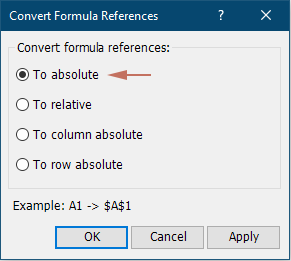如何在Excel中保持公式单元格引用不变?
在本教程中,我们将演示如何将公式中的单元格引用更改为常量(绝对)引用,以防止在公式复制到其他位置时发生更改。
下面的屏幕截图显示了用于计算项目总成本的公式中的两种不同类型的单元格引用:
- 左侧的公式错误地将折扣率引用逐行下移。当从D3复制到D4和D5时,它引用的是F4和F5,而不是F3中的固定折扣率,导致D4和D5的计算结果不正确。
- 在屏幕截图的右侧, $F$3 是一个常量(绝对)引用。它将折扣率链接到单元格 F3,无论公式在工作簿中复制到何处。因此,沿列向下复制公式可确保所有项目的折扣率保持一致。

使用F4键保持公式单元格引用不变
要使公式中的单元格引用保持不变,只需通过按F4键在列字母和行号前添加$符号即可。操作方法如下:
- 单击包含公式的单元格。
- 在编辑栏中,将光标放在要使其成为常量的单元格引用内。这里我选择引用F3。
- 按下 F4 键循环切换引用类型,直到达到绝对引用,即在列字母和行号前添加一个 美元符号 ($($)。这里 F3 将被更改为 $F$3。然后按Enter键确认更改。
现在,无论公式在工作簿中复制到何处,它都会将折扣率链接到单元格F3。

注意:每次按下F4键都会循环切换不同的引用状态:绝对引用($A$1)、混合绝对列和相对行($A1)、混合相对列和绝对行(A$1),最后回到相对引用(A1)。
只需几次点击即可使区域中的所有单元格引用变为绝对引用
上述方法有助于逐个处理单元格。如果想一次性对多个单元格应用绝对引用,强烈推荐使用Kutools for Excel的转换单元格引用功能。使用此功能,您可以通过几次点击轻松将单元格区域或多个单元格区域中的所有单元格引用设置为绝对引用。
Kutools for Excel 提供了超过 300 种高级功能,简化复杂任务,提升创造力与效率。 通过集成 AI 能力,Kutools 能够精准自动执行任务,让数据管理变得轻松简单。Kutools for Excel 的详细信息... 免费试用...
安装Kutools for Excel后,转到Kutools选项卡,选择更多 > 转换单元格引用以打开转换单元格引用对话框。然后需要执行以下操作:
- 选择一个或多个包含公式的区域,您希望将其中的所有单元格引用设置为常量。
- 选择 至绝对 选项,然后单击 确定 开始转换。

然后所选区域中公式的所有单元格引用都会立即更改为常量引用。
注意:要使用此功能,您应先安装Kutools for Excel,请点击下载并立即享受30天免费试用。
演示:使用Kutools for Excel保持公式单元格引用不变
最佳Office办公效率工具
| 🤖 | Kutools AI 助手:以智能执行为基础,彻底革新数据分析 |代码生成 |自定义公式创建|数据分析与图表生成 |调用Kutools函数…… |
| 热门功能:查找、选中项的背景色或标记重复项 | 删除空行 | 合并列或单元格且不丢失数据 | 四舍五入…… | |
| 高级LOOKUP:多条件VLookup|多值VLookup|多表查找|模糊查找…… | |
| 高级下拉列表:快速创建下拉列表 |依赖下拉列表 | 多选下拉列表…… | |
| 列管理器: 添加指定数量的列 | 移动列 | 切换隐藏列的可见状态 | 比较区域与列…… | |
| 特色功能:网格聚焦 |设计视图 | 增强编辑栏 | 工作簿及工作表管理器 | 资源库(自动文本) | 日期提取 | 合并数据 | 加密/解密单元格 | 按名单发送电子邮件 | 超级筛选 | 特殊筛选(筛选粗体/倾斜/删除线等)…… | |
| 15大工具集:12项 文本工具(添加文本、删除特定字符等)|50+种 图表 类型(甘特图等)|40+实用 公式(基于生日计算年龄等)|19项 插入工具(插入二维码、从路径插入图片等)|12项 转换工具(小写金额转大写、汇率转换等)|7项 合并与分割工具(高级合并行、分割单元格等)| …… |
Kutools支持多种语言——可选择英语、西班牙语、德语、法语、中文等40多种语言!
通过Kutools for Excel提升您的Excel技能,体验前所未有的高效办公。 Kutools for Excel提供300多项高级功能,助您提升效率并节省时间。 点击此处获取您最需要的功能……
Office Tab为Office带来多标签界面,让您的工作更加轻松
- 支持在Word、Excel、PowerPoint中进行多标签编辑与阅读。
- 在同一个窗口的新标签页中打开和创建多个文档,而不是分多个窗口。
- 可提升50%的工作效率,每天为您减少数百次鼠标点击!
所有Kutools加载项,一键安装
Kutools for Office套件包含Excel、Word、Outlook和PowerPoint的插件,以及Office Tab Pro,非常适合跨Office应用团队使用。
- 全能套装——Excel、Word、Outlook和PowerPoint插件+Office Tab Pro
- 单一安装包、单一授权——数分钟即可完成设置(支持MSI)
- 协同更高效——提升Office应用间的整体工作效率
- 30天全功能试用——无需注册,无需信用卡
- 超高性价比——比单独购买更实惠

